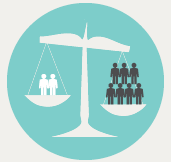Poverty and inequality remain perhaps the most stubbornly enduring developmental challenges confronting South Africa.

Poverty and inequality still exhibit a racial
footprint very similar to one that existed
prior to 1994, where sharp disparities in income
existed across the different racial groups.
Inequality levels in South Africa are ranked amongst
the highest in the world. The GCR is no exception.
While a strong social security system has provided crucial income support to the poor and effectively served as a poverty-alleviation measure, poverty levels remain very high. Looking at Gauteng, this section considers data which shows fascinating trends in terms of the broader picture of inequality in the province. Inequality by race, sex and municipality shows that there is much for policy-makers to grapple with, in order to attempt to make even the smallest dent in general levels of inequality. The background to the state of poverty and inequality in Gauteng is that of declining living standards, a ‘squeeze’ on working and poor households, increased competition for scarce resources and ever-mounting social tensions. Given the current state of research, data and knowledge on poverty and inequality, we are confronted with the crucial question: Is government able to target the 'real poor through effective poverty-alleviation programmes?




